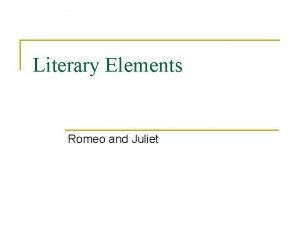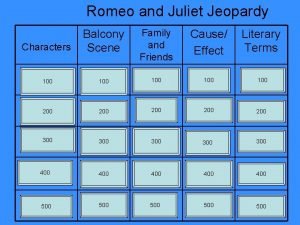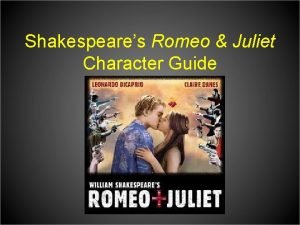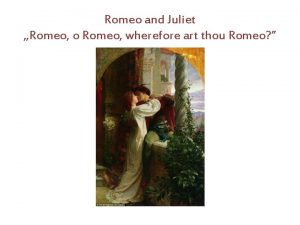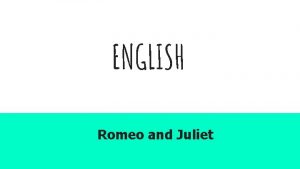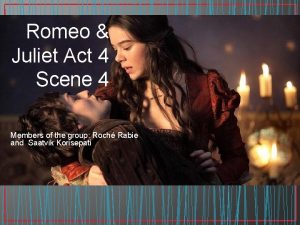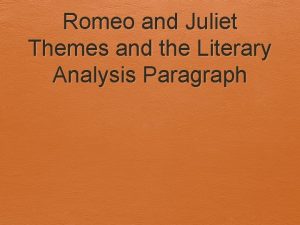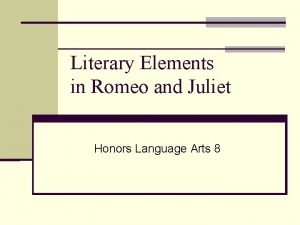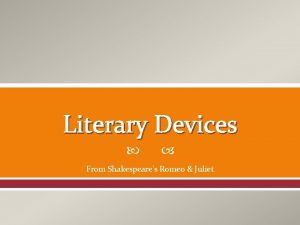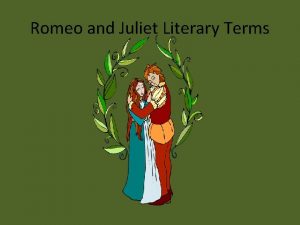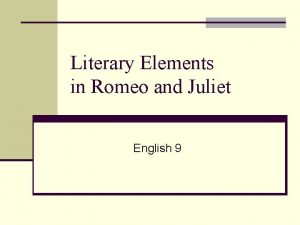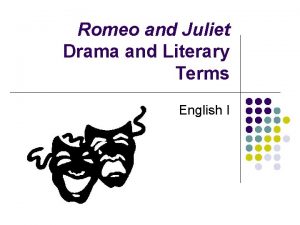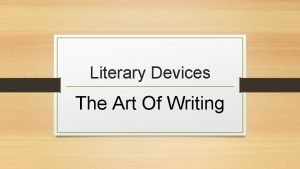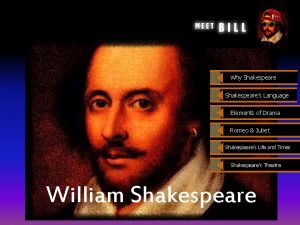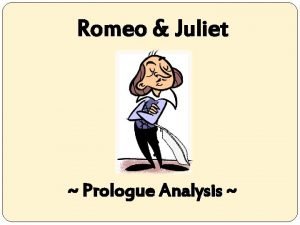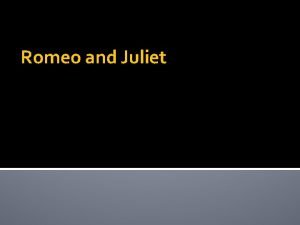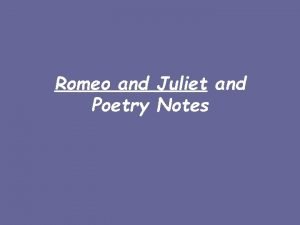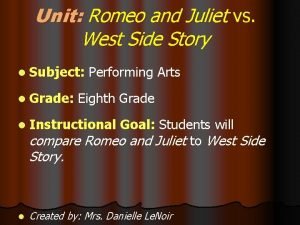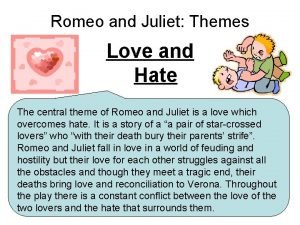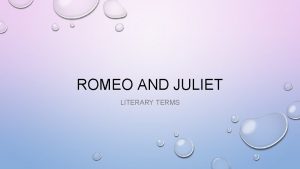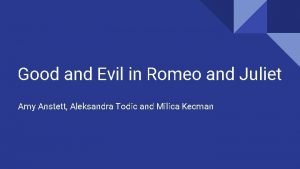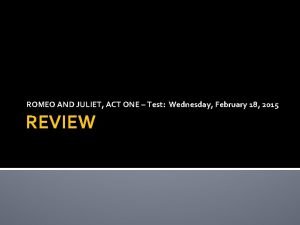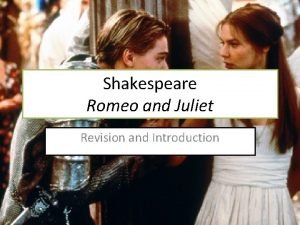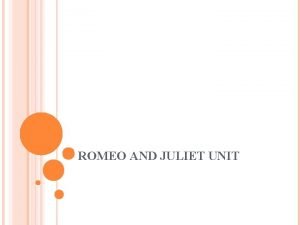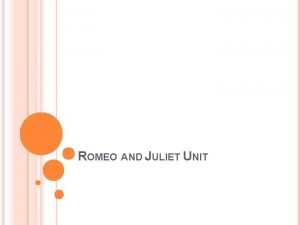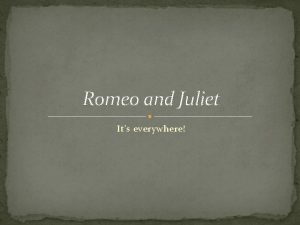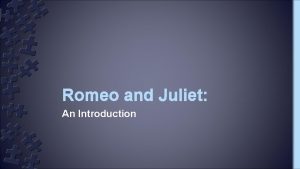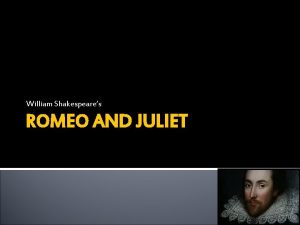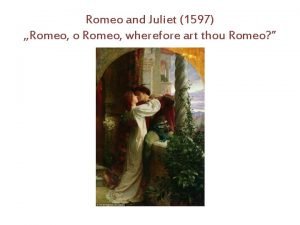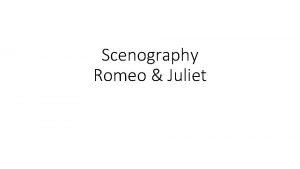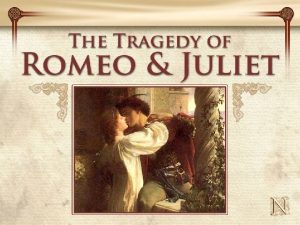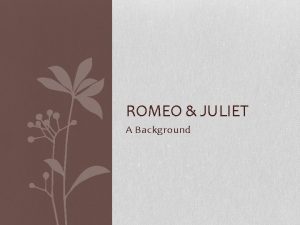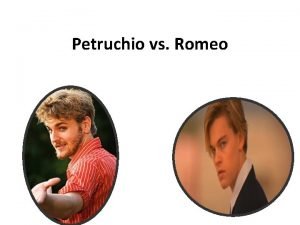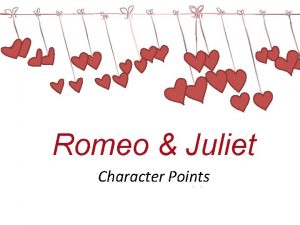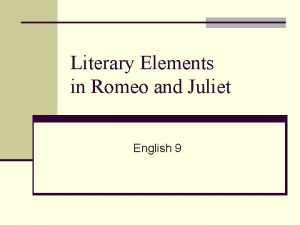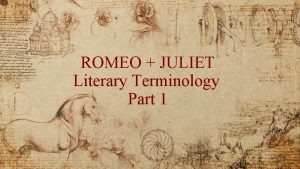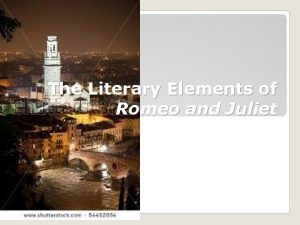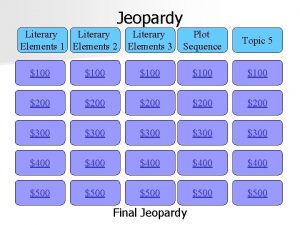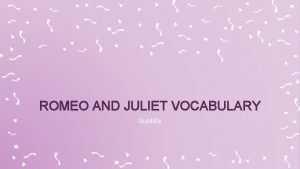Literary Elements in Romeo and Juliet English 1





























- Slides: 29

Literary Elements in Romeo and Juliet English 1 Cooper

Allusion A literary Device that stimulates ideas, associations, and extra information in the reader’s mind. A reference to a historical or literary figure, event or object.

Example from Play Act II, Scene II – Juliet says, “Else would I tear the caves where Echo lies/ And make her airy tongue more hoarse than mine/ With repetition of ‘My Romeo!’” Explanation – Echo is a nymph who could only repeat what was said to her. She could not communicate with the one she loved and lived a life of solitude in a cave. Next time you go into a cave say something and you will hear her. Juliet is saying she would say Romeo’s name over and over as if in competition with Echo.

Aside A dramatic convention by which an actor directly addresses the audience but is not suppose to be heard by other actors on the stage.

Example from the Play ACT II Scene II – Romeo says, “ Shall I hear more, or shall I speak at this? ” Explanation – Romeo is asking a rhetorical question to the audience. He is not actually speaking to any of the actors or actresses on the stage and only the audience is suppose to hear his question.

Character Foil Sets off or illuminates the major character – usually to create a contrast that is favorable to the major character.

Example from Play Act I Scene III – The nurse serves as a foil for Lady Capulet Explanation – The nurse rambles using bawdy, common language. She is frank and unrefined. Lady Capulet speaks like a noble woman. Her lines are in blank verse or rhymed couplets. Lady Capulet’s language is indirect and refined.

Chorus A characteristic device in ancient Greek drama, wherein a group of actors speaking or chanting in unison – often while dancing – convey information about the play, particularly an emotion about the action or characters.

Example from Play The Prologue at the beginning of the play is sung or chanted by a chorus. Explanation – The chorus lines are in the form of a sonnet. See the paraphrased version in your handout. You will complete a paraphrased version of the chorus in ACT II of the play.

Extended Metaphor Also known as a “conceit”, it is a metaphor that is sustained or developed through a considerable number of lines.

Example from Play The sonnet that Romeo and Juliet share before their first kiss is an extended religious metaphor. Examine the words throughout the sonnet that demonstrate how the metaphor continues: Holy, Shrine, Sin, Pilgrims, Devotion, and Saints

Foreshadowing The author uses hints and suggestions to foretell the end of the story.

Example from Play The opening Prologue foreshadows the fate of Romeo and Juliet by stating, “A pair of star-cross’d lovers take their life. ”

Hyperbole A deliberate overstatement or exaggeration. Hyperbole is often used for comic effect Example – Act II Scene III – Romeo says that the look in Juliet’s eyes is more dangerous than twenty of her kinsmen’s swords. He is saying that there is intense power in the beauty of her eyes. Several times the lovers use hyperbole to emphasize their love.

Irony Verbal irony– a figure of speech in which what is said is the opposite of what is meant. For example, Zaroff in MDG says “We try to be civilized here. ” Dramatic irony– When the reader knows more about the true state of affairs than the characters do. For example, Little Red Riding Hood.

Irony - continued Situational Irony – When there is a difference in what the reader/audience is led to expect in a situation and what actually happens. For example, Romeo goes to the party hoping to see Rosaline, but he actually meets and falls in love with Juliet.

Metaphor A figure of speech in which one thing is spoken of as though it were something else. Example: Life is a broken winged bird

Examples from Play Act 1, Scene V - Romeo compares his personality to their palms. He also compares his lips to pilgrims (suggesting piety and humility and a state of grace) "My lips, two blushing pilgrims, ready stand To smooth that rough touch with a tender kiss". Act II, Scene II - Romeo compares Juliet to the sun "But, soft! what light through yonder window breaks? It is the east, and Juliet is the sun. "

Monologue A long, uninterrupted speech that a character speaks in front of other characters

Motif Devices that continually reoccur in a work Images of light and dark throughout Romeo and Juliet.

Oxymoron Two concepts that do not go together but are used together. For example, “loving hate” and “heavy lightness” from Romeo’s dialogue with Benvolio in Act I scene I.

Paradox A statement that contradicts itself. There are more words in a Paradox than an Oxymoron. An Oxymoron is only two words, and a Paradox is similar but has other words separating the Oxymoron. For example, Juliet is upset after she hears that Romeo has killed her cousin Tybalt. She describes Romeo as a, “Book containing such vile matter so fairly bound. ”

Personification When an inanimate object or abstract noun is given human qualities or abilities. When Romeo says, “Arise, fair sun and kill thy envious moon. ”

Pun A play on words based on the similarity of sound between the two words with different meanings (“son” and “sun” or “I” and “eye”)

Simile A figure of speech in which like or as is used to make a comparison between two basically unlike ideas. Kimberly is as flighty as a sparrow

Examples from Play Act II, Scene II – Romeo says “ A thousand times the worse, to want thy light! Love goes toward love as schoolboys from their books; But love from love, toward school with heavy looks.

Soliloquy A speech in which a character, alone on the stage, addresses himself or herself to let the audience know his/her inner thoughts/feelings. ACT II Scene III Friar Lawrence is on stage alone and speaks his thoughts so only the audience can hear them.

Sonnet A poem consisting of 14 lines. Typical rhyme scheme is abab cdcd efef gg Iambic Pentameter The prologue is spoken in the form of a sonnet.

Iambic Pentameter Iambic= one unstressed syllable followed by a stressed syllable Pentameter = 10 syllables per line Almost all of Romeo and Juliet is written in blank verse (no rhyming words) using Iambic Pentameter It is very difficult to structure thoughts using this style of poetry This may explain why some of Shakespeare’s phrasings may seem odd to the reader
 Romeo and juliet oh romeo scene
Romeo and juliet oh romeo scene Alliteration from romeo and juliet
Alliteration from romeo and juliet Example of simile in romeo and juliet
Example of simile in romeo and juliet Paradox romeo and juliet
Paradox romeo and juliet Romeo and juliet family names
Romeo and juliet family names Character traits of lord montague
Character traits of lord montague Hold thy desperate hand art thou a man
Hold thy desperate hand art thou a man Asyndeton in romeo and juliet
Asyndeton in romeo and juliet Act 4, scene 2 romeo and juliet
Act 4, scene 2 romeo and juliet Romeo and juliet literary analysis
Romeo and juliet literary analysis Literary devices in romeo and juliet
Literary devices in romeo and juliet Simile romeo and juliet
Simile romeo and juliet Metaphor
Metaphor Humorous scene or speech intended to lighten the mood
Humorous scene or speech intended to lighten the mood Apostrophe in poetry
Apostrophe in poetry Literary techniques in romeo and juliet
Literary techniques in romeo and juliet Romeo and juliet elements of drama
Romeo and juliet elements of drama What is the romeo and juliet prologue in modern english?
What is the romeo and juliet prologue in modern english? Themes in romeo and juliet prologue
Themes in romeo and juliet prologue Out your
Out your Prose in romeo and juliet
Prose in romeo and juliet Wherefore art thou romeo meaning
Wherefore art thou romeo meaning Poetic device example
Poetic device example Compare and contrast west side story and romeo and juliet
Compare and contrast west side story and romeo and juliet Hate theme in romeo and juliet
Hate theme in romeo and juliet Protagonist and antagonist in romeo and juliet
Protagonist and antagonist in romeo and juliet Romeo and juliet summary act 4
Romeo and juliet summary act 4 Good and evil in romeo and juliet
Good and evil in romeo and juliet Romeo and juliet act one quiz
Romeo and juliet act one quiz Social and historical context of romeo and juliet
Social and historical context of romeo and juliet

